How to Choose the Perfect Leash for Training
Selecting the right training leash is crucial for effective dog training and behavior modification. A well-chosen leash can help you maintain control and focus your puppy's attention during walks and training sessions. Whether you're working on basic obedience or addressing specific behavioral issues, the appropriate leash can make a significant difference in your dog's progress. In this article, we'll explore the key factors to consider when selecting the ideal training leash for your canine companion.
Key Takeaways
- Choosing the right training leash depends on your dog's size, breed, and specific training needs
- Different leash types offer unique benefits for various training scenarios and environments
- Leash material, length, and features like secure clasps and comfortable handles are important considerations
- Gradual introduction and consistent daily practice are crucial for successful leash training
- Advanced leash training techniques can enhance discipline and strengthen the bond between dog and owner
Understanding Different Types of Training Leashes
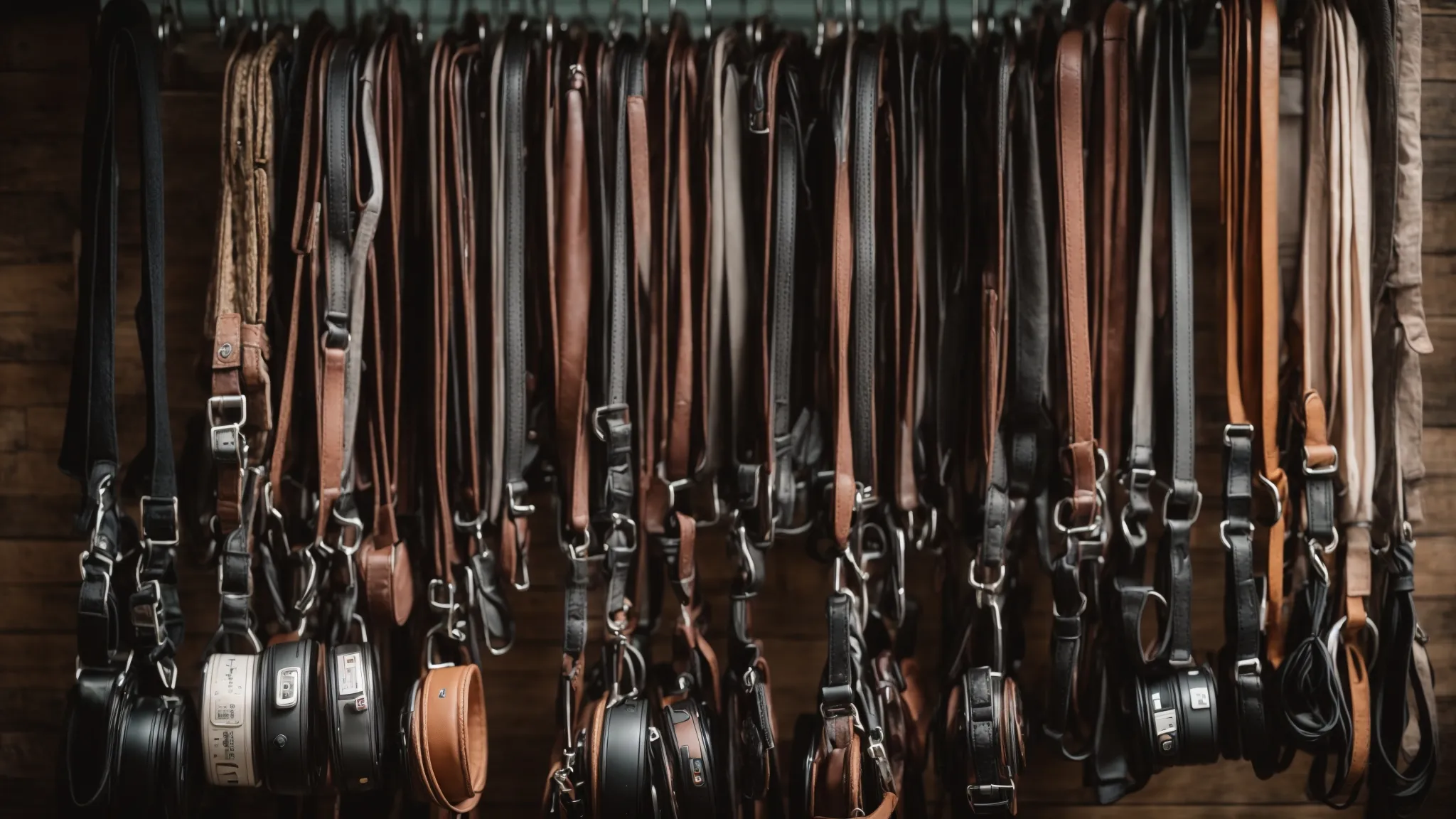
Selecting the right training leash for your dog is crucial for effective training sessions. Different leash types cater to various training needs, dog breeds, and environments. Whether you're working on basic obedience, distance commands, or specialized training techniques recommended by the American Kennel Club, the appropriate leash can enhance your dog's learning experience. From standard leashes used in crate training to harnesses that complement operant conditioning methods, each type offers unique benefits. Understanding these options will help you choose the best tool for positive reinforcement and successful training outcomes.
Standard Leashes for Basic Training
Standard leashes serve as the foundation for basic dog training, offering versatility for various breeds, from energetic terriers to loyal herding dogs. These leashes typically measure 4 to 6 feet in length, providing enough slack for your dog to explore while maintaining control during socialization exercises and obedience training.
You can use standard leashes effectively for teaching essential commands, leash manners, and even preparing dogs for therapy work. Their simplicity allows for clear communication between you and your canine companion, fostering a strong human-dog bond during training sessions.
Retractable Leashes for Controlled Freedom
Retractable leashes offer a balance between freedom and control during training sessions, making them suitable for various exercises, including dog agility. These leashes allow you to adjust the length, giving your dog more space to explore while still maintaining control through the ergonomic handle.
When used in conjunction with a proper dog harness or dog collar, retractable leashes can be effective tools for training sessions aimed at achieving the Canine Good Citizen certification. You can gradually increase the distance between you and your dog, helping to reinforce commands and build trust at varying lengths.
Adjustable Leashes for Versatile Training Situations
Adjustable leashes offer versatility for various training scenarios, from housebreaking to therapy dog preparation. You can easily modify the length to suit different environments, helping prevent dog bites during socialization exercises while maintaining control.
These leashes support your dog's health by allowing for appropriate exercise and mental stimulation during training sessions. You can adjust the leash length to accommodate your dog's energy levels and training progress, making it an ideal tool for improving sociality and obedience skills.
Long Lines for Distance Commands
Long lines, typically 15 to 50 feet in length, provide an excellent tool for teaching distance commands and recall to your dog. You can use these leashes effectively for training spaniels and other hunting breeds, as well as preparing dogs for assistance dog roles or dog show competitions.
While some trainers might resort to shock collars or punishment-based methods for distance control, long lines offer a humane alternative that reinforces positive behaviors. You can gradually increase the distance between you and your dog, allowing for safe exploration while maintaining control in various environments.
Harnesses and Their Role in Leash Training
Harnesses play a crucial role in leash training, particularly for dogs prone to fear or aggression. You can use a harness to distribute pressure evenly across your pet's chest and shoulders, reducing strain on the neck and promoting a more comfortable learning experience.
For breeds like poodles, which are known for their intelligence and trainability, harnesses can be especially effective in conjunction with positive reinforcement techniques. You'll find that harnesses provide better control during training sessions, allowing you to guide your dog gently and effectively without risking injury or discomfort.
The Importance of Choosing the Right Length
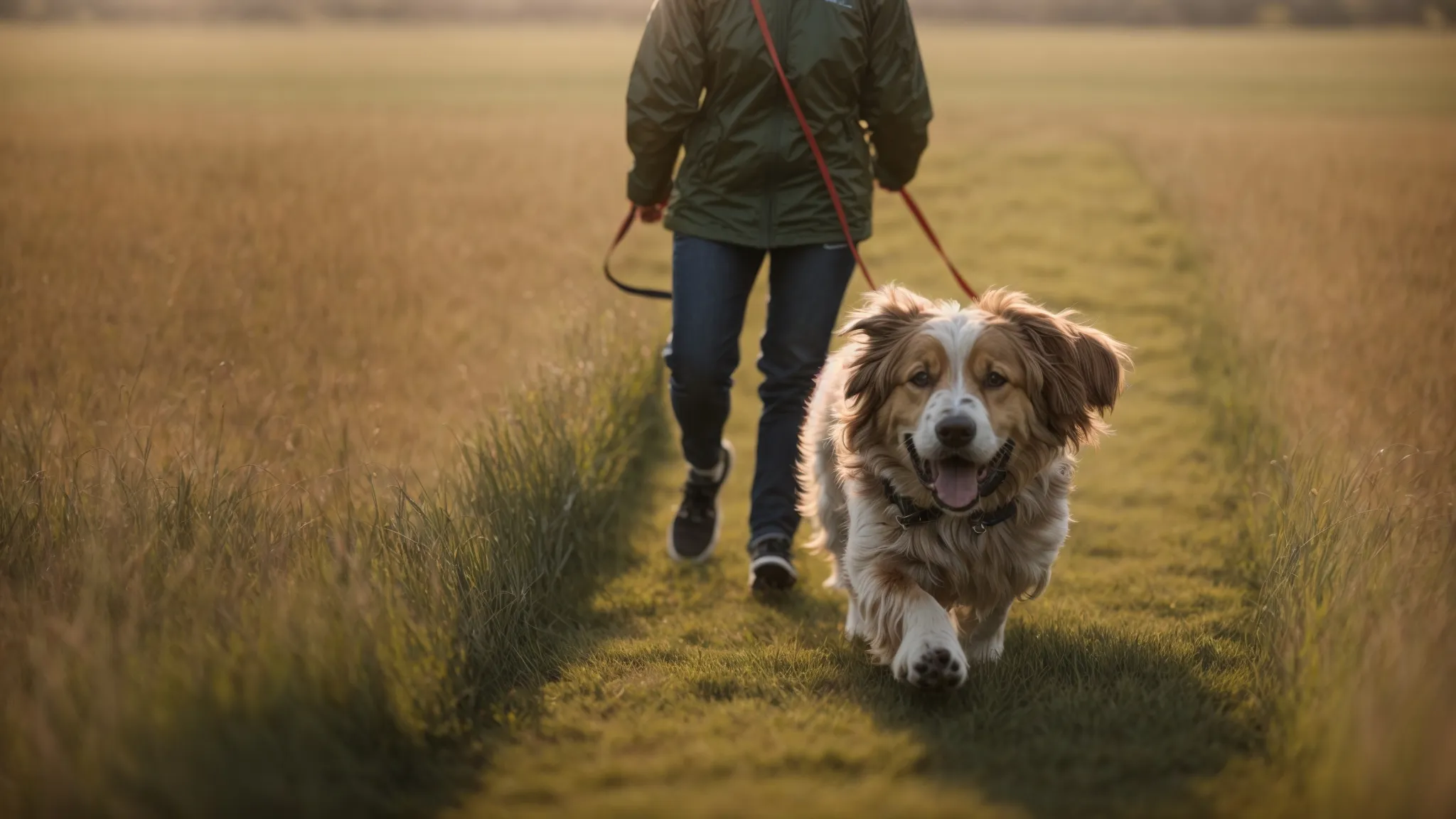
Choosing the right leash length is crucial for effective dog training, whether you're working with a toy breed or a larger detection dog. The appropriate length enables you to maintain control while allowing your canine companion enough freedom to learn and explore. Short leashes provide close control and safety in crowded areas, medium leashes offer versatility for basic training and daily walks, and long leashes are ideal for recall training and giving your dog more freedom during exercise sessions. Selecting the correct leash length also plays a vital role in agility training, helping you guide your dog through various obstacles with precision.
Short Leashes for Close Control and Safety
Short leashes provide excellent control and safety during dog walking, especially in crowded areas or when training reactive dogs. You'll find these leashes particularly useful for teaching heel commands to high-energy breeds like border collies, allowing you to maintain close proximity and offer immediate rewards with treats.
Experts recommend short leashes for improving accessibility in public spaces and enhancing your dog's focus during training sessions. You can use these leashes to prevent your dog from approaching unfamiliar people or animals, ensuring a safe and controlled environment for both your pet and those around you.
Medium Leashes for Basic Training and Walking
Medium-length leashes prove ideal for basic training and everyday walks, offering a balance between control and freedom. You'll find these leashes particularly effective when working with breeds like collies or pointers, as they allow enough slack to accommodate their natural instincts while maintaining clear communication during training sessions.
Use medium leashes to reinforce crate training exercises outside the home, gradually increasing distance from the crate while maintaining a connection with your dog. You can easily transition between close control and allowing more freedom, adapting to different training scenarios and environments without changing equipment.
Long Leashes for Recall Training and Freedom
Long leashes offer invaluable benefits for recall training and providing controlled freedom to your dog, particularly when working with high-energy breeds like schnauzers. You'll find these leashes especially useful in reducing stress and anxiety during animal training sessions, as they allow your dog to explore while maintaining a safe connection.
Use long leashes to gradually increase the distance between you and your dog, helping to reinforce recall commands and improve overall dog behavior. You can create a positive training environment that mimics off-leash situations, allowing your schnauzer or other breed to build confidence and responsiveness without the risks associated with complete freedom.
Material Matters: Selecting the Best Leash
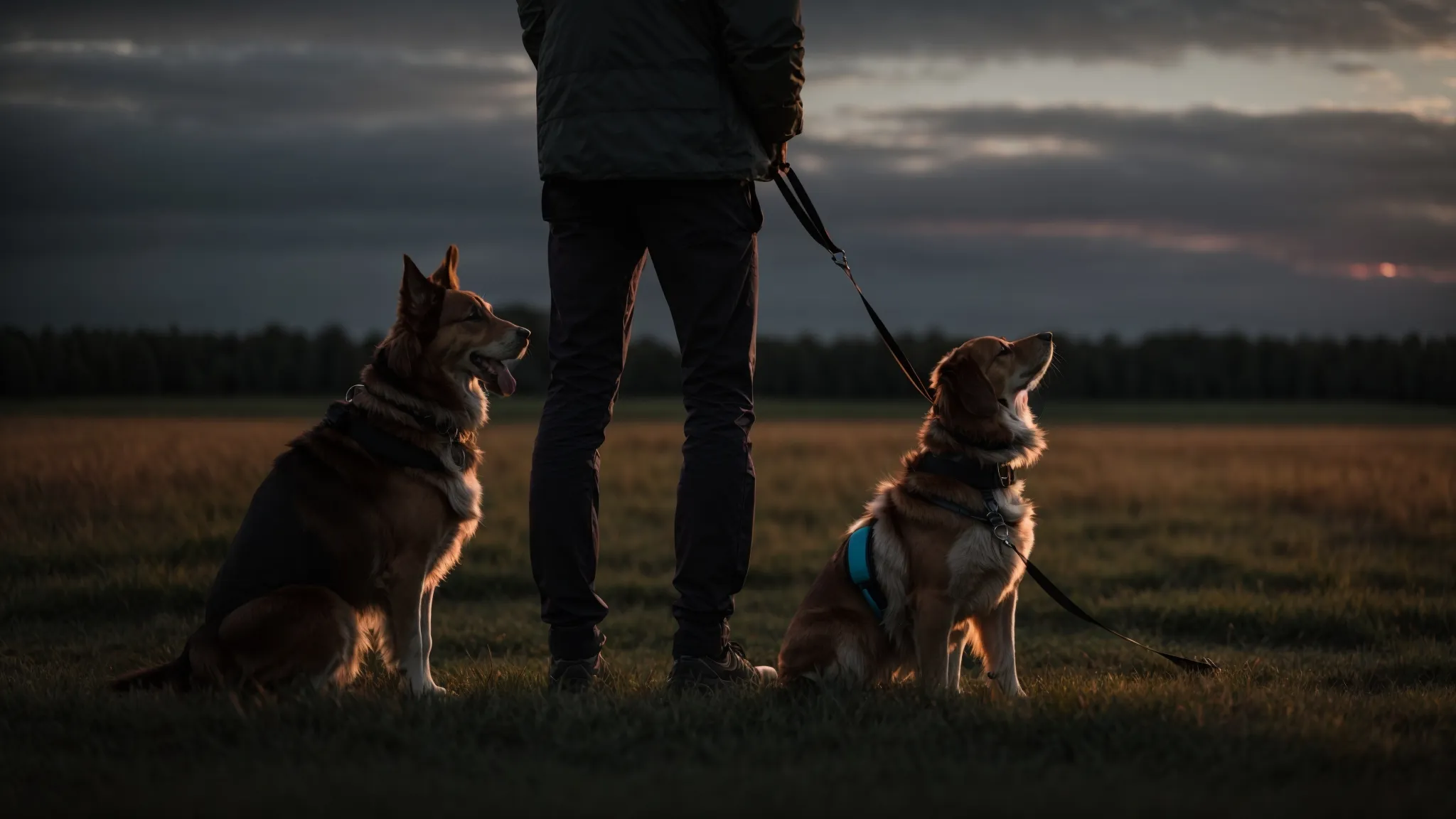
The material of your dog's training leash plays a crucial role in its effectiveness and longevity. Whether you're working with a powerful German Shepherd for search and rescue operations, a playful Cocker Spaniel, an energetic Yorkshire Terrier, or a graceful Setter, selecting the right leash material ensures optimal performance during training sessions. From durable leather options that provide comfort and control to versatile nylon leashes that withstand various weather conditions, and reflective materials for enhanced visibility during nighttime training, each material offers unique benefits tailored to specific training needs and environments.
Leather Leashes for Durability and Comfort
Leather leashes offer exceptional durability and comfort for dog training, making them an excellent choice for working with police dogs or coonhounds. You'll appreciate the sturdy construction and natural feel of leather, which provides a strong stimulus for your dog during training sessions while building confidence in both handler and canine.
When selecting a leather leash, consider the thickness and width appropriate for your dog's size and strength. Many trainers include leather leashes in their FAQ sections due to their reliability and long-lasting nature. Choose a high-quality leather leash to ensure optimal performance during various training exercises:
- Basic obedience training
- Scent work and tracking
- Agility courses
- Protection and defense exercises
- Search and rescue operations
Nylon Leashes for Versatility and Weather Resistance
Nylon leashes offer exceptional versatility and weather resistance for training various breeds, from scent hounds to guard dogs. You'll find these leashes particularly useful when working in diverse environments, as they withstand moisture, heat, and cold without compromising their integrity or your dog's comfort.
Choose a nylon leash to easily read your dog's body language during training sessions, as the lightweight material allows for subtle cues and quick adjustments. While some trainers may resort to aversives, nylon leashes provide a humane alternative that allows you to communicate effectively with your dog, conveying important information through gentle guidance rather than force.
Reflective Materials for Night-Time Safety
Reflective materials on training leashes enhance safety during night-time sessions, particularly beneficial for breeds like the Old English Sheepdog or Retriever. You'll find these leashes invaluable when practicing hunting or retrieval exercises in low-light conditions, ensuring both you and your dog remain visible to others.
The science behind reflective materials improves your ability to communicate with your dog through visual cues, even in darkness. You can effectively convey commands and reinforce training language during evening walks or early morning sessions, maintaining a clear line of sight with your canine companion.
Features to Look for in a Training Leash
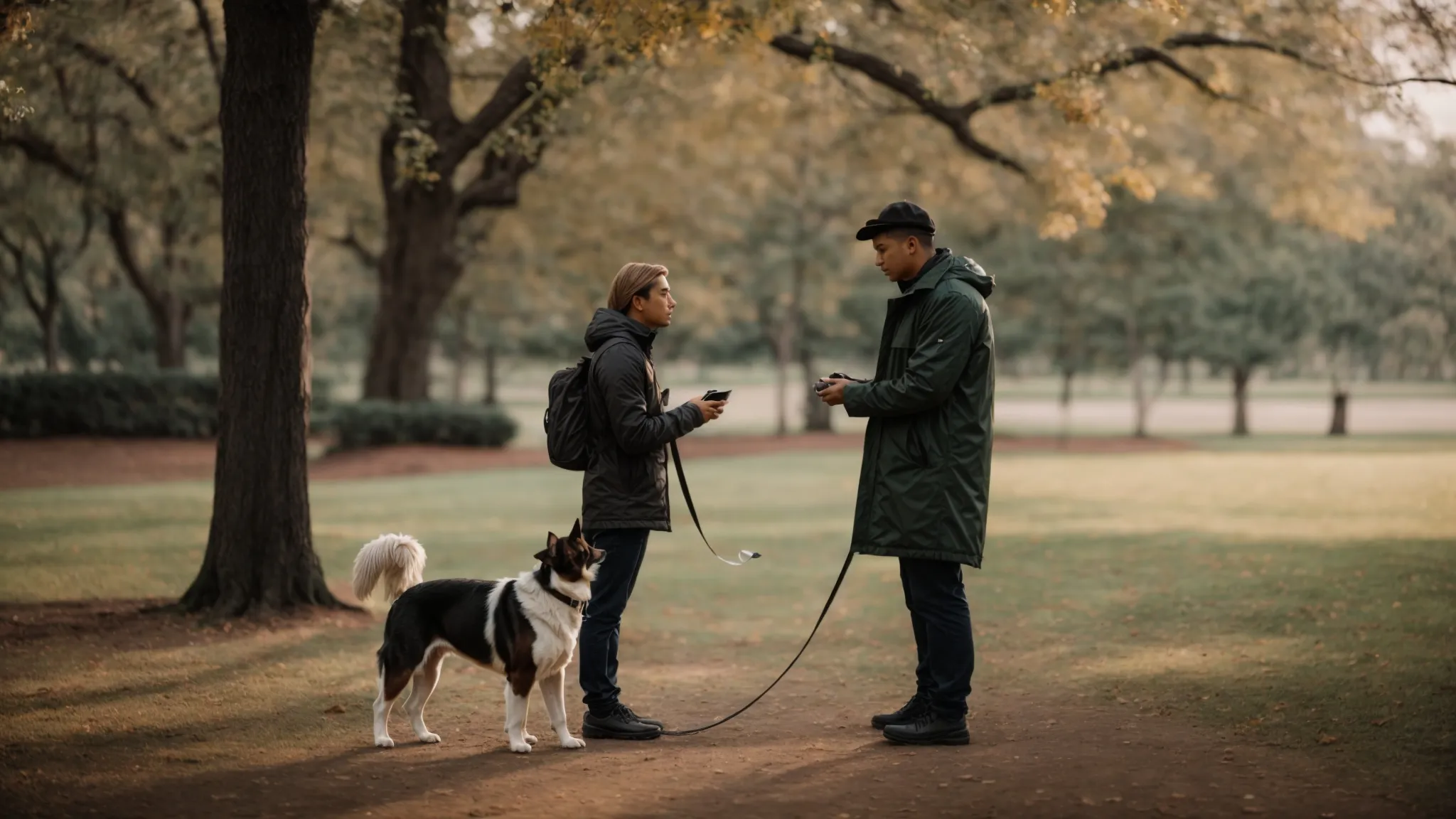
Selecting the right training leash for your Labrador Retriever or any other breed involves considering key features that enhance functionality and comfort. As renowned dog behaviorist Ian Dunbar often emphasizes in his podcasts, the tools you use significantly impact training success. When choosing a leash for your pack, look for secure clasps, comfortable handles, and built-in storage for treats and tools. These features not only facilitate effective training sessions but also make tasks like dog grooming more manageable. By focusing on these essential elements, you'll find a leash that supports your training goals and strengthens the bond with your canine companion.
Clasps and Hooks: Security Meets Convenience
Choose a training leash with secure clasps and hooks to ensure your dog's safety during flyball competitions or everyday walks. Look for high-quality brands that offer sturdy hardware capable of withstanding the strength of a mastiff or the energy of a bichon, preventing accidental escapes and providing peace of mind.
Consider leashes with quick-release clasps for convenience, especially when transitioning between training exercises or in emergency situations. This feature can be particularly useful when working with pet insurance companies, as it demonstrates responsible ownership and may contribute to lower premiums for your furry companion.
Padded Handles for Trainer's Comfort
Choose a training leash with padded handles to ensure comfort during extended sessions with your Boston Terrier or energetic Boxer. You'll appreciate the ergonomic design when tracking with a Golden Retriever or guiding a Mongrel through obedience exercises, as it reduces hand fatigue and prevents blisters.
Opt for handles with moisture-wicking materials to maintain a secure grip, even during vigorous training with high-energy breeds. You'll find that padded handles enhance your control and responsiveness, allowing for more precise communication with your dog throughout various training activities.
Built-in Treat Bags and Pockets for Training Tools
Choose a training leash with built-in treat bags and pockets to streamline your sessions with breeds like the beagle or wolf-dog hybrids. You'll find these features invaluable for reinforcing positive behaviors and maintaining your leadership role during training, allowing quick access to rewards and tools without interrupting the flow of exercises.
Look for leashes with multiple compartments to organize different types of treats, clickers, and other training aids. This design allows you to adapt your approach on the go, using the right tool or phrase for each situation, enhancing your effectiveness as a trainer and strengthening the bond with your canine companion.
Matching the Leash to Your Dog's Size and Breed
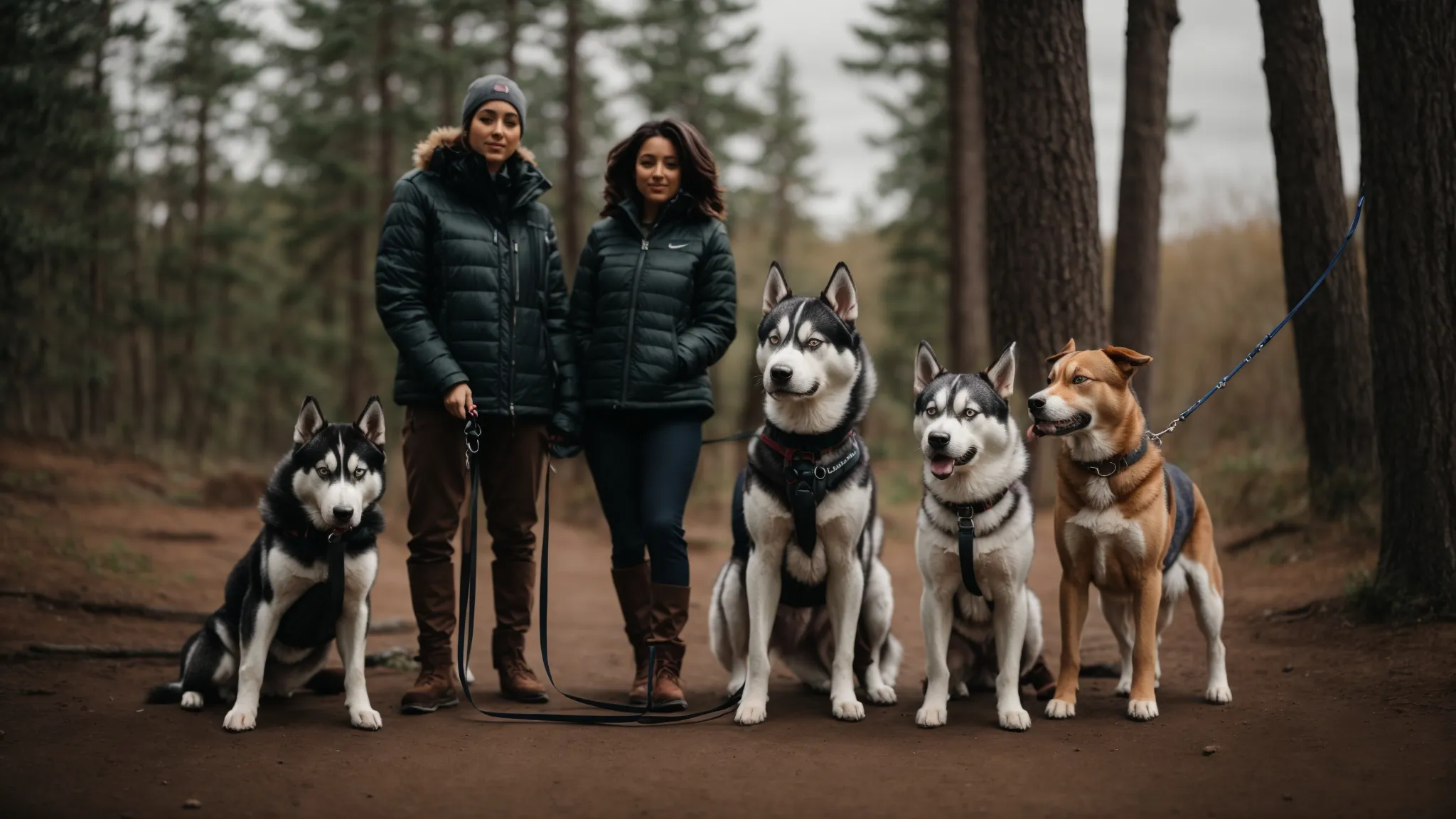
Selecting the right training leash for your dog requires careful consideration of their size, breed, and specific training needs. Whether you're working with a powerful husky or a nimble pinscher, the leash you choose can significantly impact your training success. Understanding breed-specific traits, as emphasized by renowned trainers like the Monks of New Skete, can help you tailor your approach and equipment selection. Consider your dog's psychology and behavior patterns when choosing a leash, as this can influence your training policy and methods. From lightweight options for small breeds to durable leashes for larger dogs, matching the right tool to your canine companion ensures effective and safe training sessions.
Small Breeds: Lightweight and Gentle Options
Choose lightweight and gentle leashes for small breeds like toy dogs to ensure comfort during training sessions. You'll find these options particularly suitable for delicate breeds, allowing you to guide your pet without causing strain or discomfort, even when addressing excessive barking issues.
Consider the advice of renowned dog trainers like Cesar Millan when selecting a leash for small breeds such as the Komondor. You'll enhance your dog's education by using a leash that complements their size and temperament, promoting positive learning experiences and strengthening the bond between you and your canine companion.
Large Breeds: Strong and Durable Leashes
Select strong and durable leashes for large breeds to ensure safety and control during training sessions. You'll find these options particularly suitable for powerful dogs like guide dogs or large working breeds from Portugal, allowing you to maintain control without compromising on comfort or durability.
Consider your dog's experience level and temperament when choosing a leash for large breeds, including hairless dogs. You'll enhance your training effectiveness by using a leash that can withstand the strength of your animal while providing the flexibility needed for various training exercises. Here are some key factors to consider when selecting a leash for large breeds:
- Material strength and thickness
- Reinforced stitching and hardware
- Length appropriate for the dog's size and training needs
- Comfortable grip for extended training sessions
- Resistance to wear and tear from powerful dogs
Understanding Breed-Specific Training Needs
Consider breed-specific traits when selecting a training leash for dogs like the cur or dalmatian. You'll find that understanding your dog's inherent instincts and behaviors helps you choose the most effective leash type, whether it's a standard lead or a halter for better control.
Prioritize your dog's mental health by selecting a leash that complements their natural tendencies and training needs. You can improve your training sessions by following expert tips on matching leash types to specific breeds, ensuring a positive experience for both you and your canine companion.
Integrating the Training Leash Into Your Routine
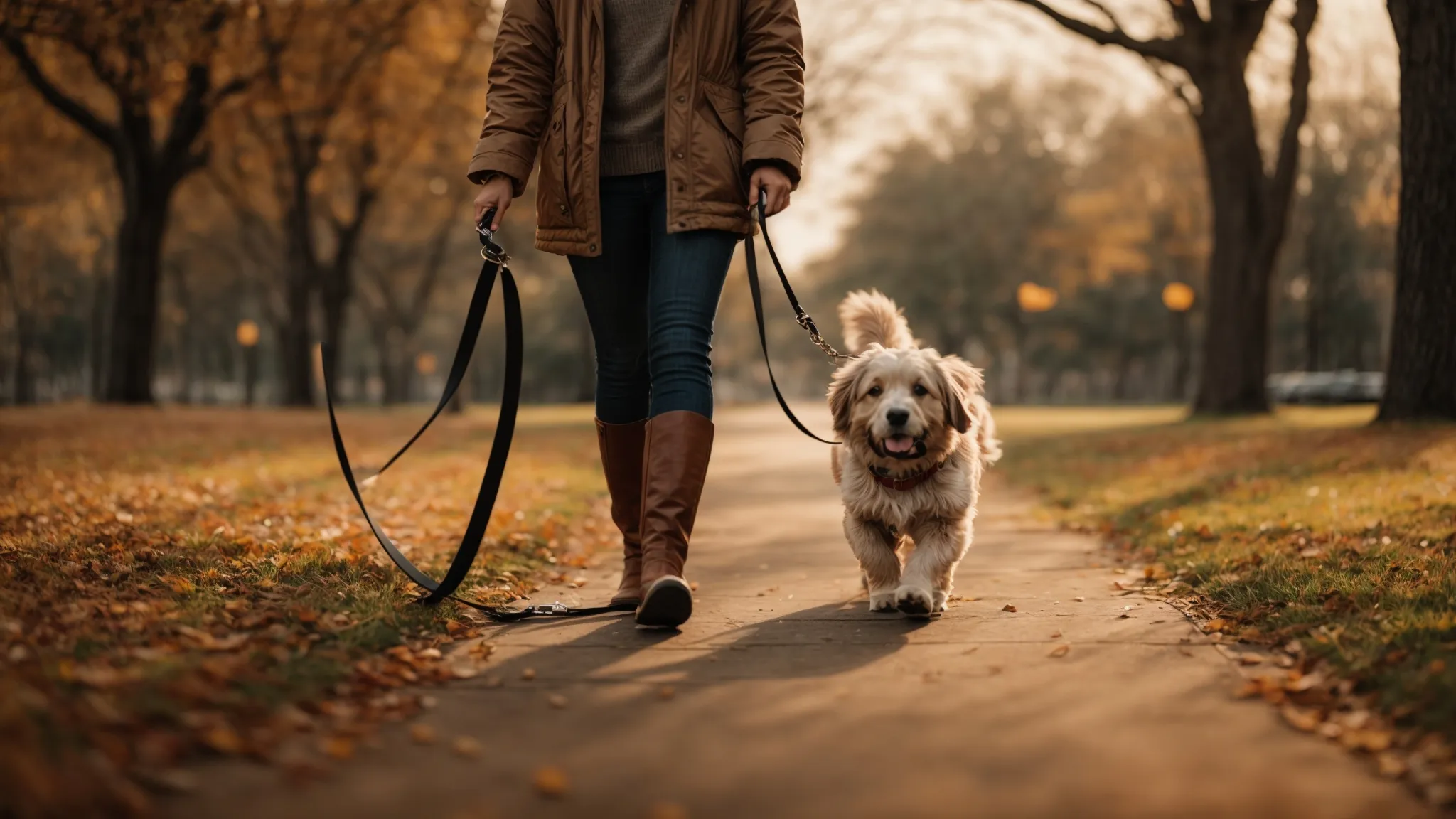
Integrating a training leash into your routine is crucial for developing a well-behaved and responsive dog. Whether you're searching for "puppy training near me" or exploring advanced techniques, the right approach can make all the difference. Positive reinforcement methods, recommended by professional trainers, help create a strong bond between you and your canine companion. As you shop for the ideal leash, consider how it will fit into your daily walks and training sessions. Many trainers offer classes that teach effective leash integration techniques, combining discipline with fun to keep your dog engaged and eager to learn.
Gradual Introduction to the Leash for Puppies
Introduce your puppy to the leash gradually, starting with short, positive experiences. Begin by letting your puppy wear the collar or harness for brief periods indoors, rewarding them with treats and praise. As you search for "dog behaviorist near me" or "dog obedience training near me," remember that consistency and patience are key to successful leash training.
Progress to attaching the leash indoors, allowing your puppy to drag it under supervision. This helps them acclimate to the sensation of the leash without pressure. When considering "crate training a puppy" or "board and train near me" options, incorporate leash familiarity into these routines for a well-rounded approach to dog obedience training.
Follow these steps for a gradual introduction to leash training:
- Allow your puppy to explore the collar or harness before putting it on
- Use treats and praise to create positive associations with the equipment
- Start with short indoor sessions wearing the collar or harness
- Introduce the leash indoors, letting your puppy drag it briefly
- Begin short outdoor sessions, focusing on positive experiences
- Gradually increase the duration of leash time as your puppy becomes comfortable
Incorporating Daily Walks and Training Sessions
Incorporate daily walks and training sessions into your routine to reinforce leash skills and build a strong bond with your dog. Whether you're working on potty training a puppy or advanced off-leash K9 training, consistent practice is key. Use tools like the BarxBuddy to address unwanted behaviors during walks, ensuring a positive experience for both you and your canine companion.
Tailor your approach to suit your dog's breed and energy levels. For example, a foxhound may require longer, more vigorous walks to meet their exercise needs. Combine these outings with training exercises to keep your dog mentally stimulated and well-behaved. Consider enrolling in dog grooming courses to learn how to keep your pet looking their best during and after these outdoor activities.
Here are some tips for incorporating daily walks and training sessions into your routine:
- Set a regular schedule for walks and stick to it
- Use walks as opportunities to practice leash manners and basic commands
- Vary your routes to provide mental stimulation for your dog
- Incorporate short training sessions into longer walks
- Reward good behavior with treats or praise during your outings
- Gradually increase the difficulty of training exercises as your dog improves
Advanced Leash Training Techniques for Discipline and Fun
Implement advanced leash training techniques to enhance discipline and enjoyment for both you and your dog. Incorporate police-style obedience exercises into your curriculum, focusing on precise movements and unwavering focus. These methods will help you develop the ultimate level of control and responsiveness from your canine companion.
Design a comprehensive training program that combines discipline with fun, keeping your dog engaged and eager to learn. Apply your knowledge of canine behavior to create challenging yet rewarding exercises that strengthen your bond and improve overall obedience. By incorporating advanced techniques, you'll elevate your training sessions to new heights of effectiveness and enjoyment.
Here are some advanced leash training techniques to incorporate into your routine:
- Practice heel work with sudden direction changes
- Introduce distractions to test focus and obedience
- Use hand signals in conjunction with verbal commands
- Implement long-distance recall exercises
- Incorporate agility elements into leash training sessions
- Practice off-leash control in secure environments
Conclusion
Selecting the ideal training leash for your dog is crucial for effective training and safety. The right leash type, length, and material can enhance your dog's learning experience, improve control, and strengthen the bond between you and your canine companion. Consider your dog's size, breed-specific traits, and training needs when choosing a leash, and look for features like secure clasps, comfortable handles, and built-in storage for treats and tools. By integrating the appropriate training leash into your daily routine and utilizing advanced techniques, you can develop a well-behaved and responsive dog while ensuring enjoyable and productive training sessions.
